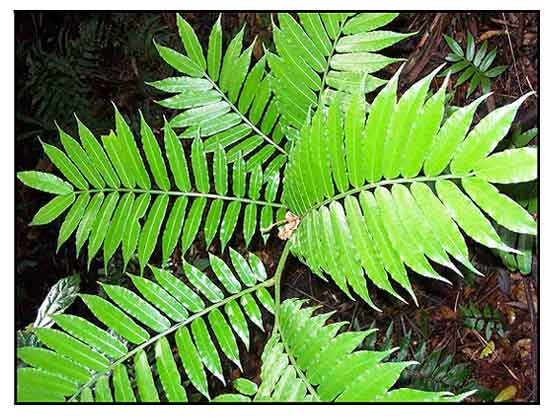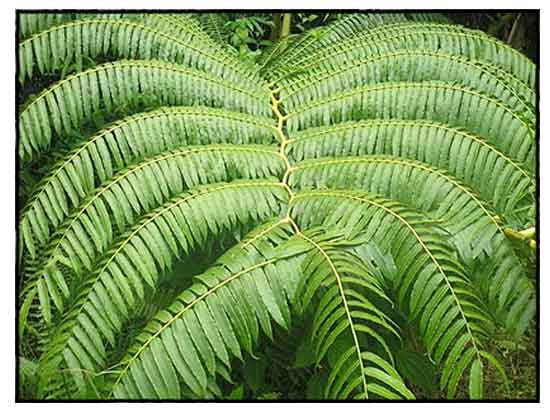 Gen info Gen info
- The Philippines has about 1,100 species of lycophytes and ferns, which represents approximately 9% of worldwide fern flora. A survey of pteridophytes of Adams, Ilocos Norte, one of the remaining floristic sites in Luzon, Philippines, recorded and vouchered 47 species, 34 genera, and 21 families of pteridophytes. Angiopteris evecta was one of six listed as "threatened".
-
Angiopteris evecta is a very large rainforest fern in the family Marattiaceae, native to most parts of Southeast Asia and Oceania. The species history dates back to very primitive, about 300 million years, suggested by fossilized fronds with distinct similarity to the plant that was found in Paleozoic rocks from every continent. It is believed to have the longest fronds of any fern in the world. It is the type species of the genus Angiopteris. (3)
- Etymology: The genus name Angiopteris derives from Ancient Greek aggeion, a vessel, and pteris, a fern
, referring to the sporangia. The species epithet evecta derives from Latin evectus meaning to carry out, bring forth, raise, or elevate. (3)
 Botany Botany
Angiopteris evecta is a fleshy, robust, terrestrial fern, developing a stout stem and tall bipinnate leaves (up to 6 m long). Rhizome short, fleshy, massive, erect, forming a clump up to 1 m tall and 0.5(-1) m in diameter, partly concealed by persistent fleshy stipules of previous and present leaves. Leaves clustered at rhizome apex; petiole about 1/3 of the leaf length, 1-1.5 m × 5 cm or more, base swollen, with a pair of fleshy, rounded stipules 5 cm long and 7 cm wide, dark green with scattered whitish streaks, glabrous but when young more or less covered with appressed, soft, brown, linear scales and hairs that are soon deciduous; blade arching, up to 6 m × 2 m, usually bipinnate, upper side dark green, slightly paler at underside; rachis green, sparsely and deciduously scaly like the petiole, especially on the underside; smaller rachides narrowly alate distally; stipes of pinnae and pinnules swollen at the base; pinnae oblong-oblanceolate in outline, 1 m long or longer, midrib with 3 grooves above, terete below; pinnules usually 30-36 on a side, 2-3 cm apart, linear-oblong, up to 20 cm × 2.5 cm, inequilateral at the base, margin serrate with a small, blunt tooth at each vein, apex acuminate-attenuate and serrulate; veins simple or forked, raised and translucent; recurrent veins slender, usually conspicuous between and parallel with main lateral veins. Sori short, submarginal in an irregular line 0.5-1.5 mm from the edge, on lateral veins, composed of a double row of 3-7 sporangia that dehisce by vertical slits to release several thousands of spores per sporangium; receptacular hairs branched, usually conspicuous. Spores trilete, globose, the surface low tuberculate to rugate. (1)
Distribution
- Native to most parts of Southeast Asia and Oceania.
- In wet tropical and subtropical primary and secondary forests, from sea level to 1200 m altitude.
- Ornamental cultivation.
- Listed as a threatened' Philippine plants (DENR Administrative Order No. 2017-11). (3)
 Constituents Constituents
- Phytochemical screening of roots for secondary metabolites yielded flavonoids, saponin, polyphenol, tannin, quinones, monoterpene and sesquiterpene, with absence of alkaloids and steroids. (6)
-
Preliminary phytochemical screening of roots for secondary metabolites yielded flavonoids, saponin, polyphenol, tannin, quinones, monoterpene and sesquiterpene, with absence of alkaloids and steroids. (6)
-
LC-MS study revealed rhizome of A. evecta yields 9.9% angiopteroside, an extremely high yield for a plant extractive. (11)
- Study of leaves isolated 4,5-dihydro-4-hydroxy-5-methyl-1H-pyran-1-one (2), angiopteroside (3) and well known stigmast-5-en-3-β-ol (1). (see study below) (12)
Properties
- Studies have suggest antihyperglycemic, analgesic, hair-growth promoting, antituberculosis, antioxidant, antibacterial, antifungal, antimalarial properties.
Parts used
Leaves, rhizomes, stems.
Uses
Edibility
- In Papua New Guinea, starchy stipules are eaten in times of starvation.
- In the Philippines, croziers (curled top of young fern) used as ingredient of stews. (1)
Folkloric
- In the Philippines, pulverized young leaves used as poultice for swellings.
-
Decoction of rhizome used to arrest discharge of blood after a miscarriage.
- Boiled rhizomes with green beans used to treat beriberi.
- In Indonesia, decoction of leaves of A. evecta and Diplazium esculentum given to pregnant women to treat backache. For severe backache, a concoction of roots of A. evecta, inflorescence of Etlingera punicea and Hedychium coronarium, and leaves of Kaempferia galanga.
- Rhizome chewed together with ginger and betel to treat spitting of blood.
- Pounded stems used as ingredient in cough medicine, and stipules as poultice for abdominal pain.
- In Papua New Guinea, leaves are bound to fractured limbs to aid healing. Mucilage from leaves applied to the body to reduce fevers. Fresh leaves used as poultice for stomach aches. (1)
- In Indonesia, used to treat baldness in children caused by high fever.
- In Vietnam, used for treatment of diabetes.
- Local people in the Kolli hills of Tamil, Nadu, use the plant for treatment of skin diseases and dysentery. Leaf decoction with lemon juice taken orally to treat intestinal ulcer and stomach aches. Tribal people of Meghalaya use the plant for treatment of headaches.
(19)
- In central Borneo, used for treatment of malaria.
Others
- Antidotal to sorcerers and love magic: In New Guinea, used as antidote to the effects of lime powder that sorcerers use. Oil from A. evecta leaf midribs used by unmarried young women who have fallen enamored having eaten from the hand of someone performing love magic -- smelling the oil will nullify its effect. (18)
Studies
• Antihyperglycemic / Analgesic / Leaves: Study evaluated the antihyperglycemic activity using OGTT and analgesic properties of leaves using acetic-induced abdominal writhings model in mice. Results showed dose-dependent reductions in blood glucose by 53.6% at 400 mg/kbw compared to glibenclamide 61.2% at 10 mg/kbw. In antinociceptive testing, there was 55.6 and 59.3% reduction in number of abdominal constrictions with 200 and 400 mg/kbw doses, compared to aspirin at 48.1 and 63.0%. Results suggest the leaves can be used for lowering blood sugar and alleviation of pain. (4)
• Hair Growth Activity / Roots: Study evaluated the hair growth activity of ethanol and water extracts of roots of A. evecta topically applied on rabbit type Anggora with hair length parameter. The ethanol extract at concentrations of 40, 20 and 10% and water extract at 40 and 20% showed better results than positive control marketed minoxidil. The 40% ethanol and water extracts showed best results compared to minoxidil. Results suggest further research on bald volunteers. (5)
• Anti-Alopecia Activity / Roots: Study evaluated the anti-alopecia activity of A. evecta Rusing ethanol 95% maceration of roots. Results showed the water fraction and n-hexane had hair growth stimulating activity; the water fraction showed best activity. Results were comparable with minoxidil. (6)
• Antihyperglycemic / Analgesic / Roots: Study evaluated the antihyperglycemic and analgesic potential of methanolic extract of A. evecta roots by OGTT and acetic acid-induced pain model. Glibenclamide and aspirin were used as standard. The methanolic extract exhibited significant antihyperglycemic and analgesic potential. (7)
• Comparison of Hair Tonic and A. evecta Gel Formulation as Hair Growth Stimulant: Study compared the hair growth promoting activities of formulations of gel and hair tonic preparations on rabbits used a modified Tanaka method. Statistically, there was no significant difference between the two formulas, and the best formula for hair tonic and gel was 10.0% and 12.5% extracts, respectively. Results suggest both may be used for stimulating hair growth. (8)
• Antituberculosis / Leaves: Study screened 78 methanol plant extracts from 70 Malaysian plant species for activity against Mycobacterium tuberculosis H37Rv using a colorimetric microplate-based assay. Thirty-eight plant extracts from 36 species exhibited antituberculosis activity with MICs range of 1600-400 µg/ml. The leaf extract of Angiopteris evecta exhibited highest activity with MIC of 400 µg/ml. (9)
• Antioxidant / Radical Scavenging: Study evaluated ten methanol extracts from various parts of seven medicinal plants commonly used in Thai traditional medicine for antioxidative and free radical scavenging activities. A. evecta and lotus leaf and pollen showed best activity in DPPH assay. Lotus leaf and A. evecta contained most abundant phenolics. A. evecta rhizome and Lotus leaf extracts (71.2% binding at 2 mg/ml) were most effective chelators. There was high correlation between metal binding capacity and OH scavenging activities. (10)
• Antibacterial / Leaves: Study of leaves isolated 4,5-dihydro-4-hydroxy-5-methyl-1H-pyran-1-one (2), angiopteroside (3) and well known stigmast-5-en-3-β-ol (1) Compound 3, angiopteroside, showed potential growth inhibitory activity against Bacillus subtilis. (12)
• Anti-Alopecia Hair Tonic: Study evaluated the anti-alopecia activity of hair tonic formulation from water fractions (7.5, 10.0, and 12.5%) of A. evecta using rabbit based on Tanaka method. Results showed hair growth activity equal or higher than control minoxidil drug. F3 10% water fraction was the best formulation. Hair tonics were safe and did not irritate the skin. (13)
• Antiproliferative / HT-29 Colon Cancer Cells: Study evaluated the antiproliferative activity of A. evecta ethanolic extracts against malignant colon cancer cells (HT-29) and nonmalignant colon cancer cells (L929). Results showed anticancer activity against HT-29 colon cancer cells without harm to L929 cells. The IC50 on HT-29 cancer cells was 15.94 µg/ml at 24 hr. Results showed dose-dependent apoptotic effect against HT-29 cancer cells. HT-29 treated cells showed DNA damage or loss of DNA content in the sub G0/G1, S phase, and G2/M phase. Maximum apoptosis took place in the G0/G1. Results showed potential antiproliferative activity with low cytotoxicity to normal cells. (14)
• Antibacterial / Antioxidant / Leaves: Study evaluated the antibacterial and antioxidant activity of methanol extract of leaves of A. evecta. Results showed inhibition zones of 11.22, 10.22, and1030 mm against S. typhi, P. acne and B. cereus, respectively. On antioxidant assays, results showed IC50 of 0.08 mg/mL on DPPH radical scavenging assay, and 3.48 mg/mL on OH radical scavenging assay. (15)
• Antibacterial / Antifungal / Leaves and Stem Bark: Study successively extracted leaves, stem bark, stem heartwood, root and tubers of A. evecta with petrol, dichloromethane, ethyl acetate, butanol, and methanol. All fractions exhibited wide spectrum of antibacterial activity. The dichloromethaneand ethyl acetate fractions of leaves and stem bark were the only fractions that exhibited antifungal activity. All tuber fractions except petrol, exhibited good antibacterial activity. (16)
• Hypoglycemic Effect / Roots: Study evaluated the hypoglycemic effects of eight Vietnamese herbs used in traditional medicine for treatment of diabetes. The extracts reduced blood glucose both orally and intraperitoneally using glucose tolerance tests in mice. Three extracts exhibited reduction in blood glucose. Angiopteris evecta at 300 mg/kg i.p. and 1500 mg/kg orally strongly reduced blood glucose levels (p<0.001). At 1000 mg/kg orally it suppressed rise in blood glucose in normal mice during oral glucose tolerance test. (17)
• Antiplasmodial Effect / Tubers: Ethanolic extract of A. evecta tubers showed in vitro antiplasmodial activity with IC50 of 2.858 µg/mL against Plasmodium falciparum. Fractionation yielded three fractions, FA, FB, and FC which showed IC50s of 37.93, 3.35, and ≥250 µg/mL, respectively. FB showed strongest inn vitro antiplasmodial activity. (20)
Availability
Wild-crafted.
Ornamental cultivation.
|

![]()





 Constituents
Constituents